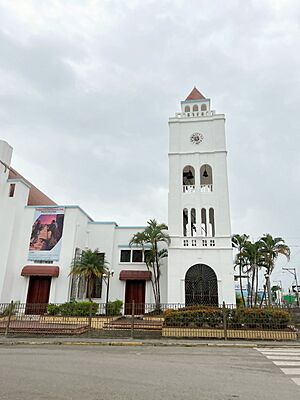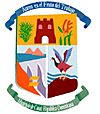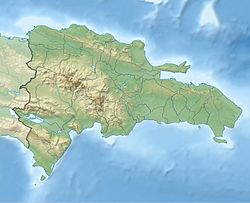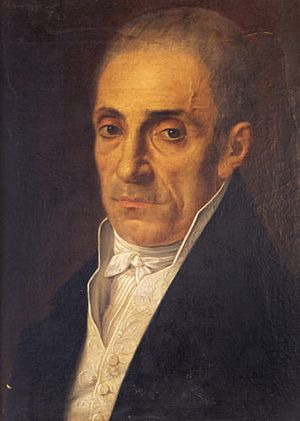Cotuí facts for kids
Quick facts for kids
Cotuí
|
||
|---|---|---|

Cotui Dominican Republic city church
|
||
|
||
| Country | ||
| Province | Sánchez Ramírez | |
| Founded | 1505 | |
| Municipality since | 1847 | |
| Area | ||
| • Total | 619.88 km2 (239.34 sq mi) | |
| Elevation | 66 m (217 ft) | |
| Population
(2012)
|
||
| • Total | 79,596 | |
| • Density | 128.4055/km2 (332.569/sq mi) | |
| • Urban | 48,998 | |
| • Demonym | Cotuisano(a) | |
| Distance to – Santo Domingo |
105 km |
|
| Municipal Districts | 4 | |
| Climate | Af | |
Cotuí is an old city in the central part of the Dominican Republic. It is one of the oldest cities in the New World, which is what people called the Americas long ago. Cotuí is the main city of Sánchez Ramírez Province in the Cibao region.
In 2012, the city area of Cotuí had about 79,596 people living there.
Contents
History
Cotuí was founded in 1505. This happened by order of Nicolás de Ovando, who was the governor of Hispaniola. The city's name comes from a Taino community. This community lived near the gold and silver mines. Spanish explorers started using these mines in the early 1500s.
Early years
A lot of gold was taken from the Spanish Island in the early 1500s. It was about 30,000 kilograms. This was more gold than all of Europe produced at that time. It was also more than the Portuguese collected in Africa.
Historian Pedro Mártir de Anglería wrote about the Cotuí mining area. He said that gold was found in porous stones and rock veins. He explained that solid and pure gold was found by breaking these rocks.
In 1533, Cotuí became known as "La Villa Mejorada del Cotuí." This means "The Improved Town of Cotuí." Its gold mine was very active and became the richest in the New World. In the 1530s, a German company worked the Cotuí gold mine. They set up a large mining camp there. A Spaniard named Francisco Dávila managed the mine for the King of Spain. When Dávila died in 1554, he left money from the mine. Ten percent of the Cotuí gold mine's earnings were for building a church in Aranda de Duero, Spain.
A strong earthquake hit Cotuí in 1562. The town had to be moved to its current spot. This new location is north of the Sierra de Yamasá mountains. It is also close to the Yuna River. In the 1600s, a historian named Nieto Valcácer studied the old site. He found the ruins of a Spanish city. These ruins showed that a huge earthquake had destroyed it. This was the same earthquake that destroyed La Concepción de La Vega in 1562. It also caused the mines to sink.
In May 1655, more than ten thousand English soldiers invaded Hispaniola. They wanted to take over the capital city. Thirty-seven skilled lancers from Cotuí went to Santo Domingo. They helped defend the city. Their swords helped stop the invaders from taking Santo Domingo. Cotuí is also the birthplace of Juan Sánchez Ramírez. He was a leader in the Battle of Palo Hincado on November 7, 1808. Juan Sánchez Ramírez led the Dominicans to defeat the French. Under his leadership, the French were driven out. This fight was called La Reconquista.
War of Independence
Juan Pablo Duarte started a secret group called La Trinitaria in 1838. Soon after, people in Cotuí organized themselves. Father Puigvert and José Valverde led them. Cotuí and San Francisco de Macorís were the first towns to remove Haitian control from their town halls. They started to govern themselves. In January 1844, Valverde and Puigvert signed a document. It was called the Manifesto of January 16. This document told the world, especially Haiti, that the Dominican people were ready for war.
After independence was declared, many people from Cotuí fought. They took part in battles against Haitian invasions. Haiti did not want to accept the independence. The Dominican people had declared their freedom on February 27, 1844.
War of Restoration
When news spread about events in Capotillo, Cotuí supported the Restoration. Hundreds of people from Cotuí went to fight. They wanted to get back the Republic that was lost. It had been joined to Spain in 1861. Esteban Adames, Basilio Gavilán, José Epifanía Márquez, Tomás Castillo, and Francisco Suriel were very important. They joined different fighting groups. Many joined the Eastern line, which was based in Cotuí. General Gregorio Luperón led this group.
Economy
Cotuí is known for its many mines. These mines produce gold, silver, iron, bauxite, marble, and nickel. The area also has very rich soil. It is home to the largest artificial lake in the Caribbean, called Presa de Hatillo. Cotuí also has clear rivers and ancient caves called Guácaras.
Farmers in Cotuí grow many crops. These include rice, plantains, cacao, pineapples, passion fruits, and yams. Some famous baseball players are from Cotuí. These include Mets pitcher Duaner Sánchez, Milwaukee Brewers pitcher José Capellán, and Los Angeles Dodger player Teoscar Hernández. Other important towns near Cotuí in Sánchez Ramírez are Villa La Mata, Fantino, La Cueva, and Cevicos.
Culture
The Immaculate Conception Church was built in 1741. It was made in a style popular in the 1600s. This style was linked to new ideas from the reign of Carlos V.
The church building lasted for over 200 years. In 1929, a bell tower was added. Workers found skeletons when digging for its base. This showed that people had been buried there long ago. An earthquake destroyed this church in 1946. A new Immaculate Conception Church opened in 1957. It stands in the same spot, across from the central park.
The Cotuí carnival comes from Spain. It also has influences from African culture. Another cultural event is the Holy Spirit festival. It happens between May and June each year. A group called a brotherhood organizes it. This celebration features playing and singing with sticks or drums. This brotherhood is the oldest in the New World. A priest named Álvaro de Castro founded it in 1529.
Like other towns in the country, Cotuí has its yearly patron saint festivities. These celebrations honor the Virgin Immaculate Conception. They start on November 30 and end on December 8. It is one of the oldest patron saint festivities in the country.
Climate
Cotuí has a tropical rainforest climate. This means it is warm and rainy all year round.
| Climate data for Cotuí (1961-1990) | |||||||||||||
|---|---|---|---|---|---|---|---|---|---|---|---|---|---|
| Month | Jan | Feb | Mar | Apr | May | Jun | Jul | Aug | Sep | Oct | Nov | Dec | Year |
| Record high °C (°F) | 34.0 (93.2) |
35.0 (95.0) |
37.2 (99.0) |
37.3 (99.1) |
38.6 (101.5) |
39.2 (102.6) |
38.6 (101.5) |
37.8 (100.0) |
38.9 (102.0) |
37.6 (99.7) |
35.3 (95.5) |
34.2 (93.6) |
39.2 (102.6) |
| Mean daily maximum °C (°F) | 29.6 (85.3) |
30.4 (86.7) |
31.5 (88.7) |
32.0 (89.6) |
32.4 (90.3) |
33.1 (91.6) |
32.9 (91.2) |
33.0 (91.4) |
33.3 (91.9) |
33.0 (91.4) |
31.3 (88.3) |
29.6 (85.3) |
31.8 (89.2) |
| Mean daily minimum °C (°F) | 18.5 (65.3) |
18.8 (65.8) |
19.8 (67.6) |
20.5 (68.9) |
21.5 (70.7) |
22.0 (71.6) |
22.1 (71.8) |
22.0 (71.6) |
21.7 (71.1) |
21.4 (70.5) |
20.6 (69.1) |
19.1 (66.4) |
20.7 (69.3) |
| Record low °C (°F) | 13.8 (56.8) |
15.0 (59.0) |
14.7 (58.5) |
15.0 (59.0) |
15.6 (60.1) |
16.8 (62.2) |
16.7 (62.1) |
16.9 (62.4) |
16.5 (61.7) |
16.5 (61.7) |
15.6 (60.1) |
15.0 (59.0) |
13.8 (56.8) |
| Average rainfall mm (inches) | 88.2 (3.47) |
98.0 (3.86) |
105.8 (4.17) |
126.7 (4.99) |
234.2 (9.22) |
149.6 (5.89) |
189.9 (7.48) |
209.1 (8.23) |
164.1 (6.46) |
161.2 (6.35) |
167.7 (6.60) |
148.9 (5.86) |
1,843.4 (72.58) |
| Average rainy days (≥ 1.0 mm) | 10.8 | 9.0 | 9.4 | 9.4 | 13.9 | 12.5 | 15.9 | 15.4 | 11.7 | 12.4 | 13.1 | 13.5 | 147 |
| Source: NOAA | |||||||||||||
Images for kids
See also
 In Spanish: Cotuí para niños
In Spanish: Cotuí para niños









